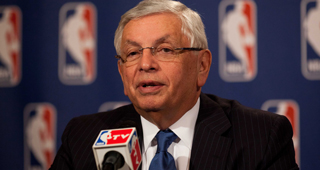At this time last year, the NBA was locked out and stuck in a holding pattern with no signs of resolution. The season was eventually saved, but not before the owners used their leverage on the players to make an absolute killing. But while there were enough labor negotiations in 1999 and 2011 to last a lifetime, the latest CBA is more ceasefire than lasting peace.
If the Mayans are wrong, both sides will have the opportunity to opt out in 2017. For a window into what the NBA owners will do, look no further than the labor disputes currently roiling the NHL and NFL. Ownership in all three has proven they are willing to sacrifice the health of their sports in order to wring every last dollar out of them.
Eight years ago, the NHL became the first American sport to lose an entire season due to a labor dispute. The NHLPA, which had vowed never to accept a hard salary cap, was forced to relent, with its executive director stepping down almost immediately after negotiations finally ended. The league has steadily gained popularity ever since, with revenue at an all-time high, $1 billion higher than in 2004-2005.
However, rather than set up a more robust revenue sharing system (which would have taken money out of each other’s pockets) in 2005, they insisted on a hard salary cap and a higher percentage of hockey-related revenue (which took money from the players). As a result, the revenue gains of the last eight years have raised the salary floor to the point where small-market teams are in trouble yet again.
The NHL’s negotiation position in 2012 is remarkably similar to the NBA’s in 2011. While the players made a good-faith effort to construct an initial proposal that was fair to both sides, the owners initial offer was so wildly one-sided that a middle finger would have sufficed instead.
They know the fans will eventually return and that the players will have more to lose in a lost season. So why not ask for the moon? That was exactly the attitude the NBA owners had last year, and they ended up negotiating an agreement that will make them billions of dollars in comparison to the previous CBA over the next decade.
At least the NBA and the NHL have weakling franchises they can trot out to justify their hard-line negotiating tactics. The NFL, in contrast, is one of the most successful business in America, with franchises that struggle to sell out home games like the Jacksonville Jaguars going for $760 million. Yet that hasn’t stopped them from treating labor negotiations as if they were a Chapter 11 company that needed employees to take pay cuts to stay in business.
Over the last month, the NFL has locked out its referees and used replacements in the preseason. With the top college referees refusing to be scabs, the owners imported referees from small colleges, high schools and even the lingerie league. The results have been predictably disastrous, with many fearing that bad calls in Week 1 will ultimately affect the playoff race and endanger player safety.
What makes the whole situation so absurd is how little money is at stake. The difference between the two sides, which revolves around the NFL’s desire to alter the referees retirement plans, comes out to $100,000 per season. The dispute isn’t about money at all; it’s a message to the referees about their place in the league’s power structure.
It’s a juvenile way to run a multi-billion dollar business, but many would say that’s the owners prerogative. That argument, however, ignores the massive public subsidies that underwrite professional sports in the US. Not only are the four major leagues allowed to act as a monopoly, and therefore eliminate any leverage their employees could have in salary negotiations, but American taxpayers have spent $15 billion dollars in new stadiums and arenas for these teams.
American sports franchises aren’t businesses in any real sense of the word; they are public trusts being operated for private gain. Rather than being indispensable, owners are completely replaceable. The Green Bay Packers are owned and operated by their fans as a non-profit corporation that reinvests profits back into their community. Yet, despite operating in the NFL’s smallest market, they are a perennial championship contender that consistently operates in the black.
Owners used to recognize this, but that’s changed over the last generation. It’s a change that mirrors society as a whole, something Christopher Hayes outlines in his excellent book “Twilight Of The Elites: America After Meritocracy”. The top 1%, whether they are owners, bankers, CEO’s or politicians, have become increasingly disconnected from the broader good and uninterested in anything beyond their own narrow personal gains.
Hayes focuses on how Ivy League colleges have changed from being bastions of the WASP establishment to having a more “meritocratic” and diverse student body. Since their graduates view their success as the result of test scores rather than family connections, they don’t feel any sense of noblesse oblige. The obsession with scores and other more “objective” ways to measure success, meanwhile, has produced an elite more adept at manipulating those numbers than anything else.
After the accounting scandals at Enron and on Wall Street over the last decade, can anyone trust the financial statements of a group with as much incentive to lie as pro sports owners? When Nate Silver of the New York Times looked at the ones they released to justify last year’s lockout, it was all he could do not to call them outright liars. While the NHL and the NFL are the ones currently suffering from the reckless indifference of their owners, it will be the NBA’s turn again soon enough.

Jonathan Tjarks wrote on the NBA for RealGM from 2011-2016 before joining The Ringer.
Follow @JonathanTjarks on Twitter.


